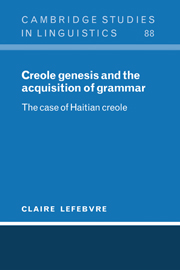Book contents
- Frontmatter
- Contents
- Tables
- Preface
- Abbreviations
- 1 The problem of creole genesis and linguistic theory
- 2 Cognitive processes involved in creole genesis
- 3 The research methodology
- 4 Functional category lexical entries involved in nominal structure
- 5 The preverbal markers encoding relative Tense, Mood and Aspect
- 6 Pronouns
- 7 Functional category lexical entries involved in the structure of the clause
- 8 The determiner and the structure of the clause
- 9 The syntactic properties of verbs
- 10 Are derivational affixes relexified?
- 11 The concatenation of words into compounds
- 12 Parameters
- 13 Evaluation of the hypothesis
- 14 Theoretical consequences
- Appendices
- Notes
- References
- Index of authors
- Index of languages and language families
- Index of subjects
10 - Are derivational affixes relexified?
Published online by Cambridge University Press: 23 November 2009
- Frontmatter
- Contents
- Tables
- Preface
- Abbreviations
- 1 The problem of creole genesis and linguistic theory
- 2 Cognitive processes involved in creole genesis
- 3 The research methodology
- 4 Functional category lexical entries involved in nominal structure
- 5 The preverbal markers encoding relative Tense, Mood and Aspect
- 6 Pronouns
- 7 Functional category lexical entries involved in the structure of the clause
- 8 The determiner and the structure of the clause
- 9 The syntactic properties of verbs
- 10 Are derivational affixes relexified?
- 11 The concatenation of words into compounds
- 12 Parameters
- 13 Evaluation of the hypothesis
- 14 Theoretical consequences
- Appendices
- Notes
- References
- Index of authors
- Index of languages and language families
- Index of subjects
Summary
Current linguistic theories maintain that derivational affixes are listed in the lexicon as individual lexical entries that are minimally specified for categorial features and selectional and semantic properties (e.g. Lieber 1980, 1992; Di Sciullo and Williams 1987; Lefebvre and Muysken 1988; Selkirk 1984). Given this general assumption, and the hypothesis that relexification plays a central role in creole genesis, lexical entries for derivational affixes are expected to undergo relexification similarly to simple nouns, verbs and so on. The comparison of the derivational affixes of Haitian with those of its contributing languages does indeed show that their properties are quite straightforwardly derivable from the process of relexification.
Section 10.1 identifies the productive derivational affixes of Haitian. In section 10.2, I compare the Haitian and French affixes. It is shown that, although the phonological representations of the Haitian affixes are derived from the phonetic matrices of French affixes, several of their other properties cannot be explained by reference to French. Section 10.3 compares the derivational affixes of Haitian with those of Fongbe, showing that the semantics of the Haitian affixes follows that of the substratum language. Section 10.4 discusses the historical derivation of the Haitian affixes within the framework of the three processes claimed to operate in creole genesis: relexification, reanalysis and dialect levelling.
This chapter draws on work by Filipovich (1988) on the morphology of Haitian, Brousseau (1990, 1993) on the morphology of Fongbe, Brousseau, Filipovich and Lefebvre (1989) and Brousseau (1994a) on Haitian, French and Fongbe morphology, and much further work of my own to complete the data, the specific analyses and the comparative analyses.
- Type
- Chapter
- Information
- Creole Genesis and the Acquisition of GrammarThe Case of Haitian Creole, pp. 303 - 333Publisher: Cambridge University PressPrint publication year: 1999



